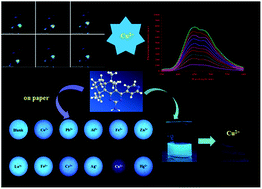A novel hexahydroquinazolin-2-amine-based fluorescence sensor for Cu2+ from isolongifolanone and its biological applications†
Abstract
Pyrimidine-based derivatives 2a–2c were synthesized from renewable isolongifolanone, and compound 2c exhibited high selectivity and sensitivity toward Cu2+ ions with a low detection limit of 4 × 10−8 M, a wide pH range (5–11), and a short response time (30 s). The sensor still retained good fluorescence selectivity to Cu2+ ions when applied to fluorescence imaging in living black mice. Therefore, compound 2c can be used as an effective fluorescence probe and imaging agent for detecting Cu2+ ions.



 Please wait while we load your content...
Please wait while we load your content...